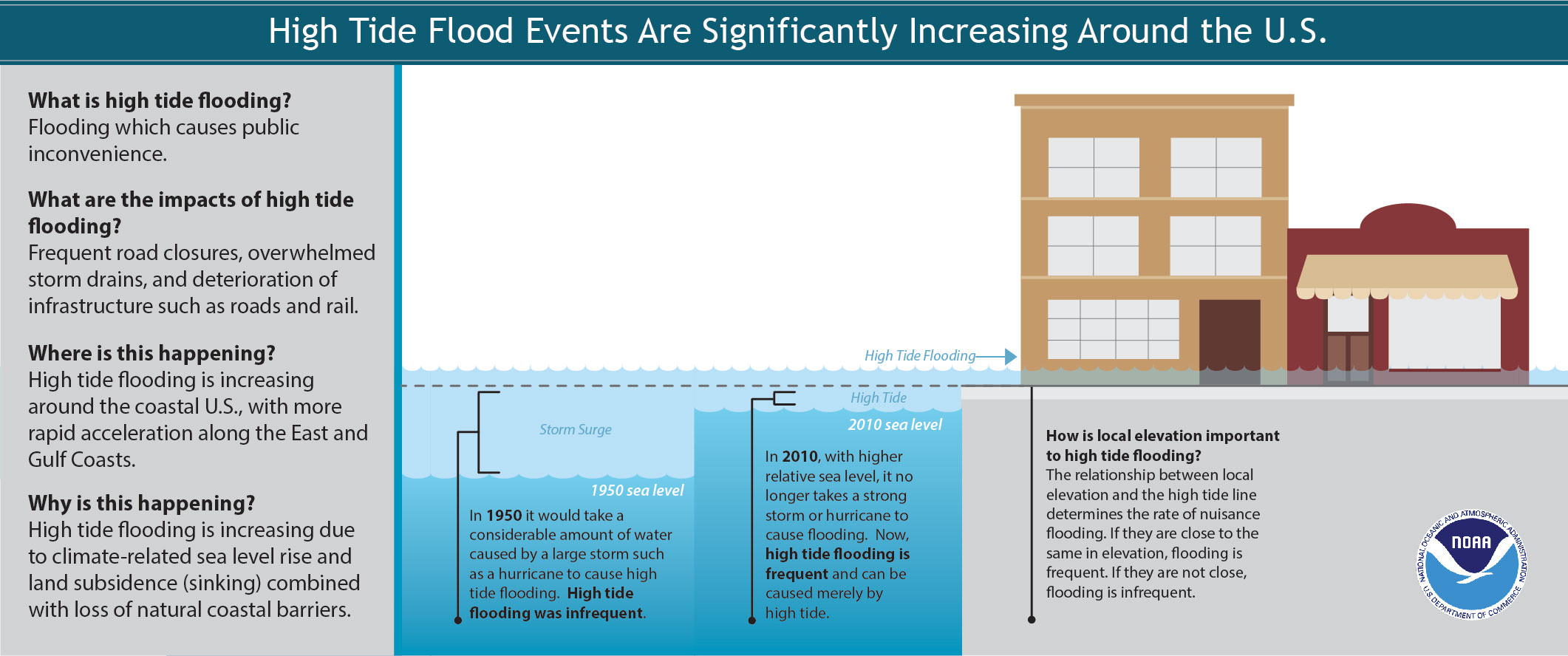High Tide Flooding Bulletin for Spring 2018
Special Stories
5 Mar 2018 9:55 AM
[Coconut Grove, Florida during King Tide, 2015. Photo by Thomas Ruppert, courtesy of Florida Sea Grant via CC license.]
From NOAA
The rising and falling of the sea is a phenomenon upon which we can always depend. Tides are the regular rise and fall of the sea surface caused by the gravitational pull of the moon and sun and their position relative to the earth. There are some factors that cause the tides to be higher than what is "normally" seen from day to day. This bulletin tells you when you may experience higher than normal high tides for the period of time between March and May 2018.



NORTHEAST OUTLOOK
Includes Maine, New Hampshire, Massachusetts, Connecticut, and New YorkWhen will the tides be higher than normal?
- May 15 - 18
Why will they be higher than normal?
- A perigean spring tide will be occurring. This is when the moon is either new or full and closest to earth. Higher than normal high tides and lower than normal low tides will occur.
- Tides will increase leading up to and after the June 21 summer solstice, due to the position of the sun relative to the equator.
- Mean sea level is typically higher due to changing weather patterns and increasing water temperatures.
What kind of impact might I expect along the coast?
- Due to the topography of the northeast (less low lying areas), tidal flooding will not likely cause a significant impact on the coast unless accompanied by storm or strong winds.
Where might I expect high tide flooding?
- Areas near the tide station at Kings Point, NY, have the greatest chance of seeing high tide flooding.
MID-ATLANTIC OUTLOOK
Includes New Jersey, Delaware, Pennsylvania, Maryland, District of Columbia, VirginiaWhen will the tides be higher than normal?
- May 15 - 18
Why will they be higher than normal?
- A perigean spring tide will be occurring. This is when the moon is either new or full and closest to earth. Higher than normal high tides and lower than normal low tides will occur.
- Tides will increase in the weeks leading up to and after the June 21 summer solstice, due to the position of the sun relative to the earth's equator.
- Mean sea level is typically higher due to changing weather patterns and increasing water temperatures.
What kind of impact might I expect along the coast?
- Minor tidal flooding along the coast, in particular in low-lying areas.
- If a storm occurs at this time, increased levels of tidal flooding and coastal erosion may occur.
- Lower than normal low tides will also occur.
Where might I expect high tide flooding?
- Areas near the tide station at Cape May, NJ, have the greatest chance of seeing high tide flooding.
SOUTHEAST OUTLOOK
Includes North Carolina, South Carolina, Georgia, Eastern Florida coastWhen will the tides be higher than normal?
- May 15 - 18
Why will they be higher than normal?
- A perigean spring tide will be occurring. This is when the moon is either new or full and closest to earth, higher than normal high tides and lower than normal low tides will occur.
- Tides will increase in the weeks leading up to and after the June 21 summer solstice, due to the position of the sun relative to the equator.
- Mean sea level is typically higher due to changing weather patterns and increasing water temperatures.
What kind of impact might I expect along the coast?
- Minor tidal flooding along the coast, in particular in low-lying areas.
- If a storm occurs at this time, increased levels of tidal flooding and coastal erosion may occur.
- Lower than normal low tides will also occur.
Where might I expect high tide flooding?
- Areas near the tide stations at Fort Pulaski, GA; Wilmington, NC; and Charleston, SC have the greatest chance of seeing high tide flooding.

GULF COAST OUTLOOK
Includes Texas, Louisiana, Mississippi, Alabama, Western Florida coastWhen will the tides be higher than normal?
- The Gulf Coast will not be significantly impacted.
Why won’t they be impacted?
- In many locations of the Gulf Coast, the tidal range is relatively small compared to other regions of the U.S, so they will not be as significantly impacted by a perigean spring tide.
WEST COAST OUTLOOK
Includes California, Oregon, Washington StateWhen will the tides be higher than normal?
- The West Coast will not be significantly impacted by high tide flooding this spring.
Why won’t this region be impacted?
- Tides alone will not be enough to cause significant flooding.
HAWAII AND THE PACIFIC ISLANDS OUTLOOK
Includes Hawaii, Guam, American Samoa, Midway, Kwajalein, and Wake IslandWhen will the tides be higher than normal?
- Hawaii and Pacific Islands will not be significantly impacted.
Why won’t this region be impacted?
- Tides alone will not be enough to cause significant flooding.
ALASKA OUTLOOK
When will the tides be higher than normal?
- Alaska will not be impacted this spring.
Why won’t this region be impacted?
- Due to the topography of Alaska (less low lying areas), tidal flooding will generally not have a significant impact on the coast unless there is a severe storm.
All Weather News
More